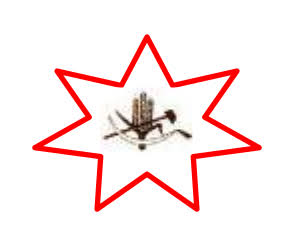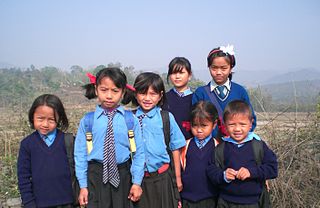
Manipur is a state in northeast India, with the city of Imphal as its capital. It is bounded by the Indian states of Nagaland to the north, Mizoram to the south and Assam to the west. It also borders two regions of Myanmar, Sagaing Region to the east and Chin State to the south. The state covers an area of 22,327 km2 (8,621 sq mi). The official and most widely spoken language is the Meitei language. Native to the Meitei people, it is also used as a lingua franca by smaller communities, who speak a variety of other Tibeto-Burman languages. Manipur has been at the crossroads of Asian economic and cultural exchange for more than 2,500 years. This exchange connects the Indian subcontinent and Central Asia to Southeast Asia, East Asia, Siberia, regions in the Arctic, Micronesia and Polynesia enabling migration of people, cultures and religions.

The Insurgency in Northeast India involves multiple separatist militant groups operating in some of India's northeastern states, which are connected to the rest of India by the Siliguri Corridor, a strip of land as narrow as 14.29 miles (23.00 km) wide.

Terrorism in India, according to the Home Ministry, poses a significant threat to the people of India. Compared to other countries, India faces a wide range of terror groups. Terrorism found in India includes Islamic terrorism, ultranationalist terrorism, and left-wing terrorism. India is one of the countries most impacted by terrorism.

The People's Revolutionary Party of Kangleipak (PREPAK) is an armed insurgent group in Manipur demanding a separate and independent homeland. PREPAK was formed under the leadership of R. K. Tulachandra in 1977.

The Naga conflict, also known as the Naga Insurgency, is an ongoing conflict fought between the ethnic Nagas and the governments of India in northeastern India. Nagaland, inhabited by the Nagas, is located at the tri-junction border of India on the West and South, north and Myanmar on the East.
Moreh is a border town located on the India–Myanmar border in Tengnoupal district of the Indian state of Manipur. As a rapidly developing international trade point with the integrated customs and international immigration checkpoint, Moreh plays an important role in India's Look East Policy, trade and commerce under ASEAN–India Free Trade Area, India-Myanmar relationship, India–Myanmar–Thailand road connectivity, and Trans-Asian Railway connectivity.

The National Socialist Council of Nagaland (NSCN) is a Naga militant and separatist group operating mainly in northeastern part of India, with minor activities in northwest Myanmar (Burma). The main aim of the organisation is allegedly to establish a sovereign Naga state, "Nagalim", which would consist of all the areas inhabited by Naga tribes in Northeast India and northwest Myanmar. India claims that China and Pakistan provide financial support and weaponry to the NSCN. Drug trafficking and extortion are believed to be other major sources of income for the NSCN.

Karbi Longri N.C. Hills Liberation Front was a militant group operating in Karbi Anglong district and Dima Hasao district of Assam, India. Thong Teron was the general secretary of KLNLF. Karbi Anglong NC Hills People's Resistance was the armed wing of the organization. KLNLF emerged from the United People's Democratic Solidarity, being against the peace talks between the UDPS and the government. After the split, there has been turf wars between the two groups.
The Kuki–Paite Conflict, also called Kuki–Zomi Conflict, was an ethnic conflict during 1997–1998 between tribal communities in Churachandpur district in Manipur, India. The cause of the conflict may be regarded as the desire for leadership within the tribes, pitting one group that subscribed to the Kuki label against another group that subscribed to the Zomi label, the latter being led by the Paites. The conflict started in June 1997 and lasted for over year, during which 352 people died, thousands of homes were destroyed and over 13,000 people were displaced. The Government of India sent in the Indian Army to attempt to stop the violence, but peace was restored in September–October 1998 only with the initiative of the Church.

The Zomi Revolutionary Army (ZRA) is an armed Zomi nationalist militant group formed in 1997, following an increase in ethnic tensions between the Kuki people and the Paites tribe in Churachandpur district of Manipur, India. Its parent organisation, the Zomi Re-unification Organisation, was founded in April 1993.
Secession in India typically refers to state secession, which is the withdrawal of one or more states from the Republic of India. Whereas, some have wanted a separate state, union territory or an autonomous administrative division within India. Many separatist movements exist with thousands of members, however, some have low local support and high voter participation in democratic elections. However, at the same time, demanding separate statehood within under the administration of Indian union from an existing state can lead to criminal charges under secession law in India. India is described as an ‘Union of States’ in Article 1 of the Indian constitution I.e "Indestructible nation of destructible states" by its father of constitution Dr. Bhimrao Ramji Ambedkar where a state or Union territory of India cannot secede from India by any means and the Central Government has more powers than the respective state governments and can forcefully change the names and boundaries of the states without their permission at any time when needed for self interest and for the maintenance of integrity.
The Naga Peace Accord is a peace treaty, signed, on 3 August 2015, between the Government of India, and the National Socialist Council of Nagaland (NSCN), to end the insurgency in the state of Nagaland in Northeast India. The Government’s interlocutor for Naga Peace Talks, R. N. Ravi signed it on behalf of the Government of India, whereas Lt. Isak Chishi Swu, Chairman and Thuingaleng Muivah, General Secretary signed on behalf of the NSCN, in presence of the Indian Prime Minister, Narendra Modi.
On 9 June 2015, India conducted a cross-border strike code name Operation Hot Pursuit against insurgents belonging to NSCN-K. According to India, the operation took place in Myanmar and it was in response to ambush of Indian Army convoy of 6 Dogra Regiment in Chandel district of Manipur. Indian officials said that they had crossed the border and inflicted significant casualties against the NSCN-K. According to Indian media reports, around 38 insurgents belonging to NSCN-K were killed during the operation. The operation lasted around 40 minutes.

Shangwang Shangyung Khaplang was a Burmese leader of Naga ethnicity. He was the leader of the NSCN-K, an insurgent group that operates to establish a Greater Nagaland, a sovereign state bringing all Naga-inhabited areas of Myanmar and India under one administrative setup.
This is a timeline of the Insurgency in Northeast India, an ongoing armed conflict between the separatist rebels and the Indian government.

The hill tribes of Northeast India are hill people, mostly classified as Scheduled Tribes (STs), who live in the Northeast India region. This region has the largest proportion of scheduled tribes in the country.

The history of the Nagas dates back centuries, but first appear in written records of Ahom kingdom during the medieval period of Indian history. Aside from developing contacts with the Ahom kingdom, which was established in 1228 in Assam, the Nagas generally lived an isolated existence from the outside world. This changed in the 19th century, when the Burmese Empire launched several invasions of Assam between 1817 and 1826, which led the Nagas to briefly fall under Burmese rule. However, the neighboring British Empire annexed Assam in 1828 following the 1826 Treaty of Yandabo.
In 1992, violent clashes broke out between two tribal groups, the Nagas, and the Kukis, in the northeastern Indian state of Manipur Though it was popularly known as the Kuki-Naga clash, many other tribes of the Chin-Kuki-Mizo group were also affected. The clashes lasted almost seven years until 1999.
The International Meeteis Forum is a Meitei ethnic advocacy group in the Indian state of Manipur. Its objectives are to assert Meitei indigeneity in Manipur, to unify Meiteis around the world, to campaign for the territorial integrity of the Manipur state and to block the influx of alleged foreigners. Founded in 2012 by a retired army officer R. K. Rajendro, it later teamed up with the Federation of Haomee with similar ideological motivations. Both the organisations generated free-flowing hate speech against the Kuki community of Manipur, labelling them as "immigrants" or "foreigners", which was instrumental in the generation of 2023 Manipur violence.
The 2011 Tirap Ambush was a violent clash within the National Socialist Council of Nagaland (NSCN) between the NSCN--Isak Muivah (NSCN-IM) and the NSCN--Khaplang (NSCN-K) militant groups on the Indo-Myanmar border of Tirap district, in Eastern Arunachal Pradesh, India.











